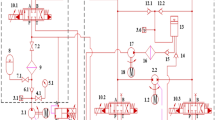Abstract
The natural frequency of the electrohydraulic system in mobile machinery is always very low, which brings difficulties to the controller design. To improve the tracking performance of the hydraulic system, mathematical modeling of the electrohydraulic lifting system and the rubber hose was accomplished according to an electrohydraulic lifting test rig built in the laboratory. Then, valve compensation strategy, including spool opening compensation (SOC) and dead zone compensation (DZC), was designed based on the flow-pressure characteristic of a closed-centered proportional valve. Comparative experiments on point-to-point trajectory tracking between a proportional controller with the proposed compensations and a traditional PI controller were conducted. Experiment results show that the maximal absolute values of the tracking error are reduced from 0.039 m to 0.019 m for the slow point-to-point motion trajectory and from 0.085 m to 0.054 m for the fast point-to-point motion trajectory with the proposed compensations. Moreover, tracking error of the proposed controller was analyzed and corresponding suggestions to reduce the tracking error were put forward.
Similar content being viewed by others
References
ANG K H, CHONG G, LI Yun. PID control system analysis, design, and technology [J]. IEEE Transactions on Control Systems Technology, 2005, 13 (4): 559–576.
ERYILMAZ B, WILSON B H. Unified modeling and analysis of a proportional valve [J]. Journal of the Franklin Institute, 2006, 343 (1): 48–68.
ROVIRA-MÁS F, ZHANG Qin, HANSEN A C. Dynamic behavior of an electrohydraulic valve: Typology of characteristic curves [J]. Mechatronics, 2007, 17 (10): 551–561.
VALDIERO A C, GUENTHER R, DE NEGRI V J. New methodology for identification of the dead zone in proportional directional hydraulic valves [C]// Proceedings of the 18th Brazilian Congress of Mechanical Engineering. São Paulo, Brazil: COBEM, 2005: 377–384.
LIU G P, DALEY S. Optimal-tuning nonlinear PID control of hydraulic systems [J]. Control Engineering Practice, 2000, 8(9): 1045–1053.
WANG Zhong-hua, ZHANG Yong, FANG Hui. Neural adaptive control for a class of nonlinear systems with unknown deadzone [J]. Neural Computing & Applications, 2008, 17(4): 339–345.
MACHADO C L D, DE NEGRI V J, CUNHA M A B. Experimental implementation of the cascade controller with adaptive dead-zone compensation applied to a hydraulic robot [C]// IEEE Latin American Robotic Symposium. Natal, Brazil: LARS, 2008: 59–64.
IBRIR S, XIE Wen-fang, SU Chun-yi. Adaptive tracking of nonlinear systems with non-symmetric dead-zone input [J]. Automatica, 2007, 43(3): 522–530.
BESSA W M, DUTRA M S, KREUZER E. An adaptive fuzzy dead-zone compensation scheme and its application to electro-hydraulic systems [J]. Journal of the Brazilian Society of Mechanical Sciences and Engineering, 2010, 32(1): 1–7.
BESSA W M, DUTRA M S, KREUZER E. Sliding mode control with adaptive fuzzy dead-zone compensation of an electro-hydraulic servo-system [J]. Journal of Intelligent & Robotic Systems, 2010, 58(1): 3–16.
KONG Xiao-wu, WEI Jian-hua, QIU Min-xiu, WU Gen-mao. Improvement of fluid pipe lumped parameter model [J]. Chinese Journal of Mechanical Engineering, 2004, 17(1): 114–116.
MERRITT H E. Hydraulic control systems [M]. New York: John Wiley & Sons Inc, 1967: 14–18.
ÅSTRÖM K J, HÄGGLUND T. The future of PID control [J]. Control Engineering Practice, 2001, 9(11): 1163–1175.
WANG Qing-feng, GU Lin-yi. Research on calculated flow feedback control method and its characteristic [J]. Chinese Journal of Mechanical Engineering, 1999, 35(4): 96–98. (in Chinese)
LIANG Xi-ming, LI Shan-chun, HASSAN A B. A novel PID controller tuning method based on optimization technique [J]. Journal of Central South University of Technology, 2010, 17(5): 1036–1042.
LU Liang, ZOU Jun, FU Xin, RUAN Xiao-dong, DU Xue-wen, RYU S, OCHIAI M. Cavitating flow in non-circular opening spool valves with U-grooves [J]. Proceedings of the Institution of Mechanical Engineers, Part C: Journal of Mechanical Engineering Science, 2009, 223(10): 2297–2307.
Author information
Authors and Affiliations
Corresponding author
Additional information
Foundation item: Project(2006CB705400) supported by the National Basic Research Program of China
Rights and permissions
About this article
Cite this article
Zhou, H., Hou, Jy., Zhao, Yg. et al. Model-based trajectory tracking control for an electrohydraulic lifting system with valve compensation strategy. J. Cent. South Univ. 19, 3110–3117 (2012). https://doi.org/10.1007/s11771-012-1386-6
Received:
Accepted:
Published:
Issue Date:
DOI: https://doi.org/10.1007/s11771-012-1386-6



